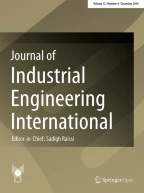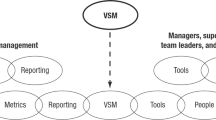
Automobile sector forms the backbone of manufacturing sector. Vehicle assembly line is important section in automobile plant where repetitive tasks are performed one after another at different workstations. In this thesis, a methodology is proposed to reduce cycle time and time loss due to important factors like equipment failure, shortage of inventory, absenteeism, set-up, material handling, rejection and fatigue to improve output within given cost constraints. Various relationships between these factors, corresponding cost and output are established by scientific approach. This methodology is validated in three different vehicle assembly plants. Proposed methodology may help practitioners to optimize the assembly line using lean techniques.

Avoid common mistakes on your manuscript.
Attaining manufacturing excellence to gain leadership and competitive advantage has become necessity of hour over last few years. Some of the challenges in automobile industry are demands of customers, price sensitivity, environmental and safety concerns, automation, etc. Vehicle assembly line is vast, complex and involves many components received from vendors and other departments. Higher cycle time, lengthy changeover time, unnecessary buffers, bottlenecks, inadequate resource utilization are common issues. Thus, objective is to analyze and resolve all these issues scientifically without increasing manufacturing cost. For improving assembly line performance, different approaches are used by researchers which includes use of lean techniques, classical mathematical models, process simulation using commercial software’s, meta-heuristic approach, cost based approach, integrated approach, etc. Few researchers work is presented here in brief.
Gokcen and Erel (1998) demonstrated basic assembly line balancing model to minimize number of stations. Bergen et al. (2001) have focused on constraint-based vehicle assembly line sequencing. Model was tested with three different algorithms and two constraints. Distribution constraint allows the assembly line worker to ensure that at least a certain amount of every order is produced prior to any unexpected line shutdowns while ‘Change-over’ constraints prohibit undesirable transitions. Authors demonstrated improvements averaging 11.6% using Branch and Bound algorithm.
Ali and Seifoddini (2006) addressed effect of factors like machine breakdown, labor dynamics, material arrival and unpredictable customer orders. Authors have simulated response to stochastic variations. Sandanayake et al. (2008) identified the impact of set-up time, number of workstations and inspection on process time by regression modeling. It is also noted that few researchers have used statistical tools. Torenli (2009) improved the output by identifying bottlenecks and wastes. New layout was suggested.
Major efforts are seen to develop faster algorithms and to compare their results. Chica et al. (2011) have used various search algorithms like Simulated Annealing, Genetic algorithm etc. for minimizing number of workstations. Author demonstrated that Genetic Algorithm-II is better than others. Kuo and Yang (2011) verified the results of FlexSim software with Particle Swarm Optimization to reduce waiting time. Kanda et al. (2013) used Maynard Operation Sequence Technique (MOST) for improving the productivity at Maruti Suzuki. Falck and Rosenqvist (2014) have explained cost of rejection exhaustively while Hakami et al. (2014) presented various mathematical models for different assembly line parameters.
Jadhav et al. (2015) have presented a roadmap for Lean implementation in Indian automotive component industry. Authors have proposed Interpretive Structural Model for sustainable Lean implementation. Chramcov et al. (2015)proposed mathematical model for robotic automated line to minimize assembly time. Authors have included heuristic algorithms in their simulation model for control determining of the assembly line.
Lee et al. (2016) have considered effect of monotony on workers performance to improve the productivity. Authors have demonstrated five step design framework towards gamification approach for bolt tightening work. Dao et al. (2017) have put forward modern virtual computer-integrated manufacturing system. Authors have proposed Genetic algorithm to find optimised solution which is verified by a numerical example. Kia et al. (2017) studied a dynamic flexible flow line problem with sequence-dependent set-up times to minimize mean flow time and mean tardiness. Authors have used genetic programming as well as discrete-event simulation model to examine the performances of scheduling rules.
Due to many factors and complexity of vehicle assembly line, mathematical modeling is tedious. Methodologies developed demands redesigning of line which attracts re-investment. Many researchers have studied the influence of individual factor like skill, breakdown, layout, priority and buffer on output. However, no work is reported to achieve cost constrained pragmatic solution for integrated effect of set-up, equipment failure, skill level of workers, absenteeism, material shortage, rejection, fatigue, material handling, etc. on output. Also, effect of interaction between these factors on output is not reported.
Based on data, literature review and discussion with domain experts, objective of the present research is to propose methodology to “Optimize vehicle assembly line performance using simulation based approach” within imposed cost constraints.
In the present research, detailed analysis of various vehicle assembly lines is conducted at three different plants; wherein data collection and analysis are carried out.
A typical vehicle assembly line consists of many workstations, where the components are assembled sequentially in a fixed pattern repeatedly and continuously as shown in Fig. 1.
There is a fixed precedence between these stations. Workers move with the moving conveyor to complete the task of that stage and reposition themselves to their initial position to work on the subsequent vehicle which might have arrived at the upstream stage. There are three main assembly lines viz. Trim, Chassis and Finish. Progress of each vehicle can be tracked by means of its Vehicle Identification Number and a small radio frequency transponder attached to the chassis. Figure 2 shows the layout of the assembly line at plant A which is commissioned on 2nd October 1965.
Trim lines 1 and 2 consist of 33 stations numbered from 41 to 73. While work is being carried out at Trim line, simultaneously chassis is loaded on chassis line consisting of workstations numbered from 1 to 17. Finish line starts from station 18 till 40. As the chassis passes along the conveyor, the body from the Trim line is placed onto the chassis at workstation 18. Parallel workstations viz. 3,14,15,16,38,39,40, Windshield and Electricals are called as Feeder stations. Similarly assembly lines of two more plants were studied. Plant B is commissioned on 31st March 2009, manufacturing different models of car while Plant C is commissioned on 31st March 2001 and manufactures different models of commercial vehicles. Lines were studied in terms of layout, automation level, inventory, cycle time, resources, material handling, ergonomics, etc.
Output of assembly lines is affected by many factors. Major factors affecting the output and which are considered in this thesis are; (1) time lost due to equipment failure (T bd), 2) time lost due to shortage of material (T inv), (3) time lost due to absenteeism (T ab), (4) time lost due to set-up (T setup), (5) Time lost due to rejection (T rej), (6) time lost due to material handling (T mh) and (7) time lost due to fatigue (T f). Independent factors are taken as T bd, T inv and T ab as they control T setup, T mh, T rej and T f. It is required to minimize this time loss to improve the output. As the output is governed by the slowest station (bottleneck station), it is necessary to identify bottleneck station.
To identify bottleneck station, MOST is used at all stations. MOST divides the task into smallest activities. Table 1 gives summary of MOST study. At workstation 1, operator 6 takes maximum time, i.e., 87.17 s, which is termed as process time of workstation 1. So product moves out of workstation 1 at every 87.17 s to workstation 2. MOST data of all station is not presented here due to space constraints. In Table 1, W.S. no. and Op indicates workstation number and operator, respectively. Numbers inside the cell (except first column) represents task timing in seconds.
The models developed are as below.